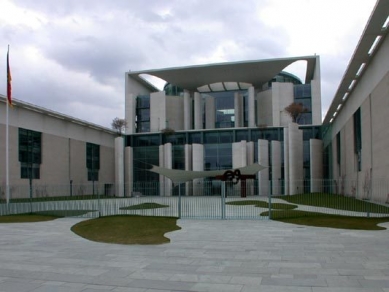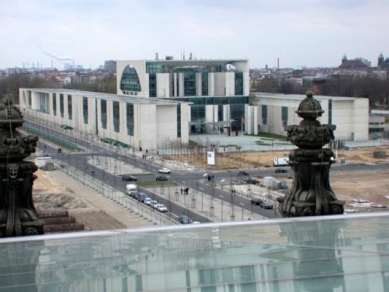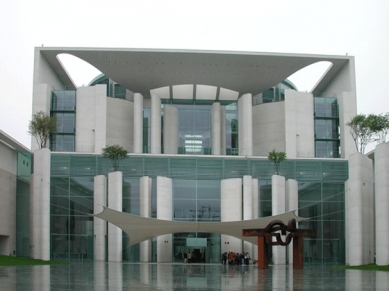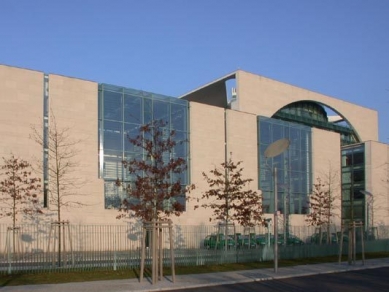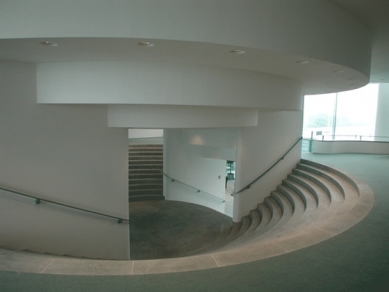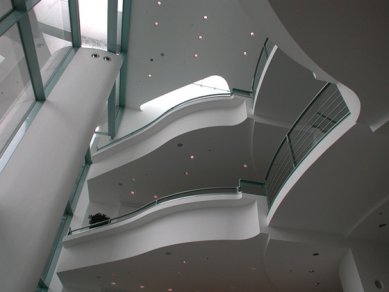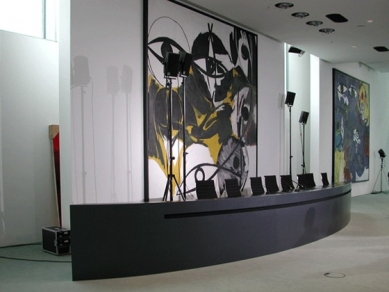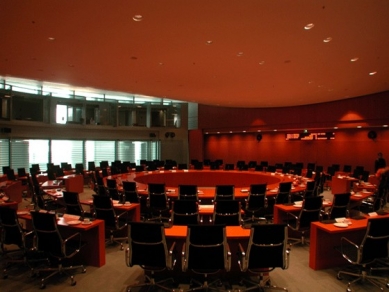
Chancellery Office
<translate>Federal Chancellery</translate>

Shouldn't you have something smaller? asked Gerhard Schröder when he first viewed the project of his predecessor Helmut Kohl. He was referring to the monumental nature of the building, which was tailored for the ex-chancellor and earned the nickname Kohloseum.
The new, modern chancellery office by the Spree resembles a white fortress from the outside, while inside it is an architectural gem. In the complex that cost 465 million marks, which is 65 million marks more than originally anticipated, 510 employees work behind walls made of concrete and armored glass eight centimeters thick. The H-shaped complex has 370 offices separated by thirteen winter gardens. Two rooms serve for meetings of the federal government. On the highest, eighth floor is the residence of the German chancellor. The massive building, which Berliners have nicknamed "the federal washing machine" due to its unusual shape, quickly became a tourist magnet. At a recent Open House Day, crowds of tourists queued before it, some waiting for several hours.
In the courtyard sits the black Mercedes Cabrio of the first federal chancellor Konrad Adenauer. On the lower floors, there is much modern art and an exhibition about the Bonn chancellery (by Günter Behnisch). Many have already forgotten about it. The chancellery building in Bonn, which Willy Brandt had built and whose first tenant Helmut Schmidt referred to as the Rhenish savings bank, was a symbol of the "Bonn Republic": an inconspicuous building hidden in a park that was meant to express how radically the state distanced itself from the grandeur of Nazism, even in architecture.
In Berlin, modernity with futuristic elements prevailed. "It isn’t very beautiful, but it is impressive,” said Ulf Lohse about the interior, who waited in line for an hour at the recent Open House Day in Berlin. Massive columns flank the glazed entrance. The amount of glass somewhat lightens the cube made of light sandstone. When you take the elevator to the "chancellor's" floor, you have a beautiful view of the largest park in central Berlin - Tiergarten.
Given the monumentality of the building, you might be surprised by the small dimensions of the chancellor's office itself. The room, which is only 2.7 meters tall, feels somewhat dark. And Schröder's apartment on the eighth floor is definitely not luxurious: a living room with a gray-blue carpet chosen by his wife Doris, a bedroom, a bathroom, and a toilet for guests.
One of the largest and undoubtedly economically strongest countries in Europe should be a model for us in the approach of politicians to architecture. Not in grand gestures, but in trust in the future and modern architecture. I feel sick when I think of the massive occupation of the political historic center of Prague. The ruling classes are settled in renovated aristocratic residences, thus suggesting that practically nothing has changed since the Baroque period. I cannot recall any significant modern government building since Prager's parliament on Wilson Street, which celebrated its thirtieth anniversary last year.
The new, modern chancellery office by the Spree resembles a white fortress from the outside, while inside it is an architectural gem. In the complex that cost 465 million marks, which is 65 million marks more than originally anticipated, 510 employees work behind walls made of concrete and armored glass eight centimeters thick. The H-shaped complex has 370 offices separated by thirteen winter gardens. Two rooms serve for meetings of the federal government. On the highest, eighth floor is the residence of the German chancellor. The massive building, which Berliners have nicknamed "the federal washing machine" due to its unusual shape, quickly became a tourist magnet. At a recent Open House Day, crowds of tourists queued before it, some waiting for several hours.
In the courtyard sits the black Mercedes Cabrio of the first federal chancellor Konrad Adenauer. On the lower floors, there is much modern art and an exhibition about the Bonn chancellery (by Günter Behnisch). Many have already forgotten about it. The chancellery building in Bonn, which Willy Brandt had built and whose first tenant Helmut Schmidt referred to as the Rhenish savings bank, was a symbol of the "Bonn Republic": an inconspicuous building hidden in a park that was meant to express how radically the state distanced itself from the grandeur of Nazism, even in architecture.
In Berlin, modernity with futuristic elements prevailed. "It isn’t very beautiful, but it is impressive,” said Ulf Lohse about the interior, who waited in line for an hour at the recent Open House Day in Berlin. Massive columns flank the glazed entrance. The amount of glass somewhat lightens the cube made of light sandstone. When you take the elevator to the "chancellor's" floor, you have a beautiful view of the largest park in central Berlin - Tiergarten.
Given the monumentality of the building, you might be surprised by the small dimensions of the chancellor's office itself. The room, which is only 2.7 meters tall, feels somewhat dark. And Schröder's apartment on the eighth floor is definitely not luxurious: a living room with a gray-blue carpet chosen by his wife Doris, a bedroom, a bathroom, and a toilet for guests.
Zita Senková, MF Dnes
One of the largest and undoubtedly economically strongest countries in Europe should be a model for us in the approach of politicians to architecture. Not in grand gestures, but in trust in the future and modern architecture. I feel sick when I think of the massive occupation of the political historic center of Prague. The ruling classes are settled in renovated aristocratic residences, thus suggesting that practically nothing has changed since the Baroque period. I cannot recall any significant modern government building since Prager's parliament on Wilson Street, which celebrated its thirtieth anniversary last year.
The English translation is powered by AI tool. Switch to Czech to view the original text source.
0 comments
add comment


